Zircon U–Pb Ages and Geochemistry of Diaoluoshan Granite, Hainan Island: Implications for Late Cretaceous Tectonics in South China
Abstract
1. Introduction
2. Geological Settings
3. Methods
4. Results
4.1. Zircon U-Pb Age
4.2. Petrogeochemical Characteristics
4.3. Mineralogical Characteristics
5. Discussion
5.1. Rock Type
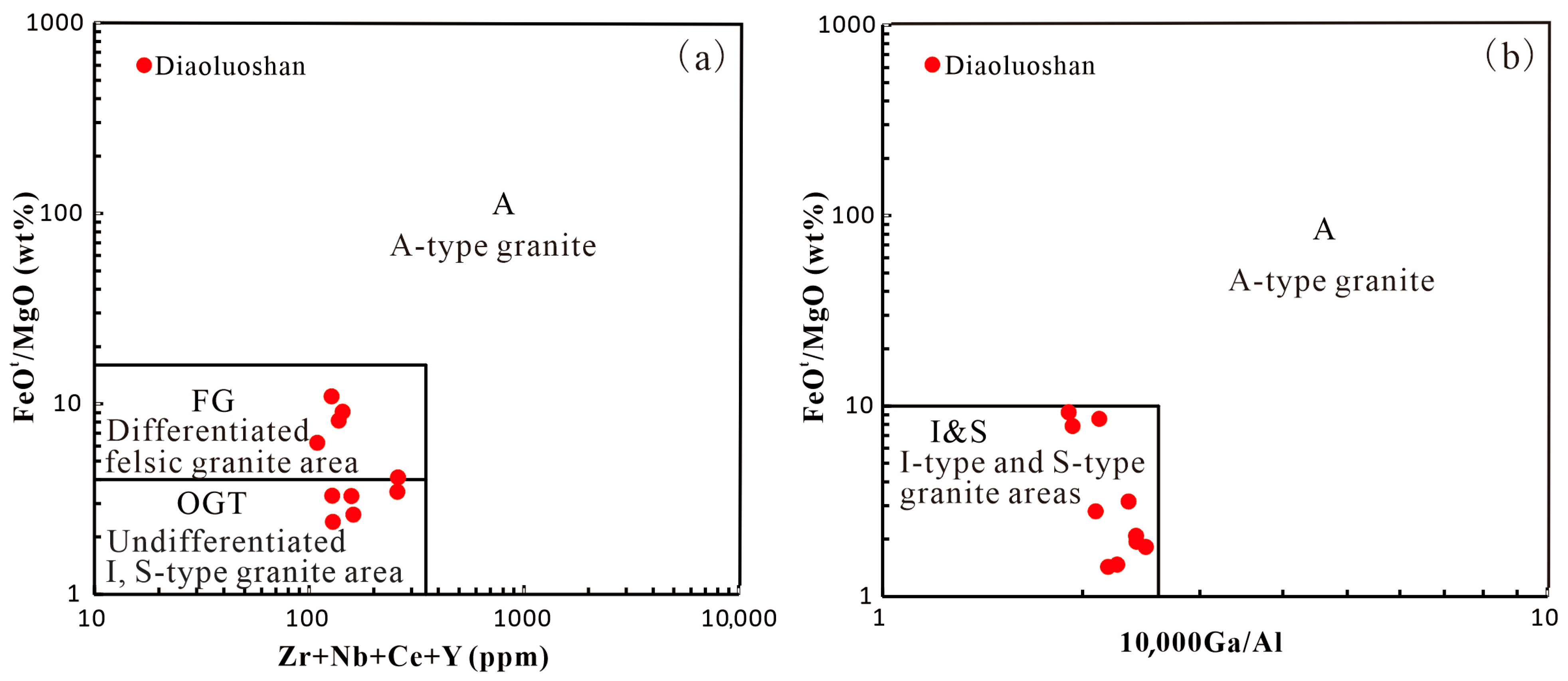
5.2. Petrogenesis and Magma Source Characteristics
5.3. Tectonic Setting
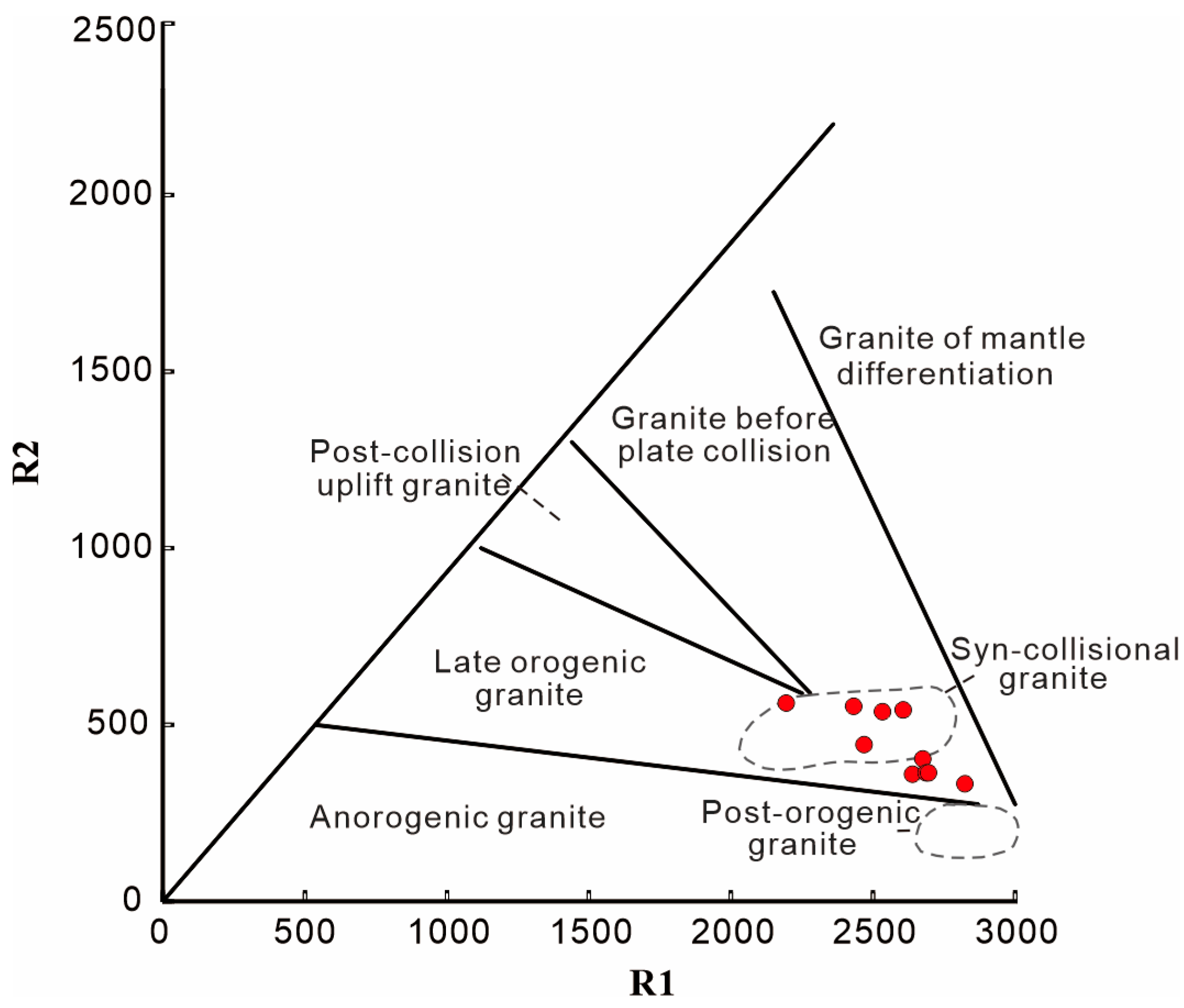
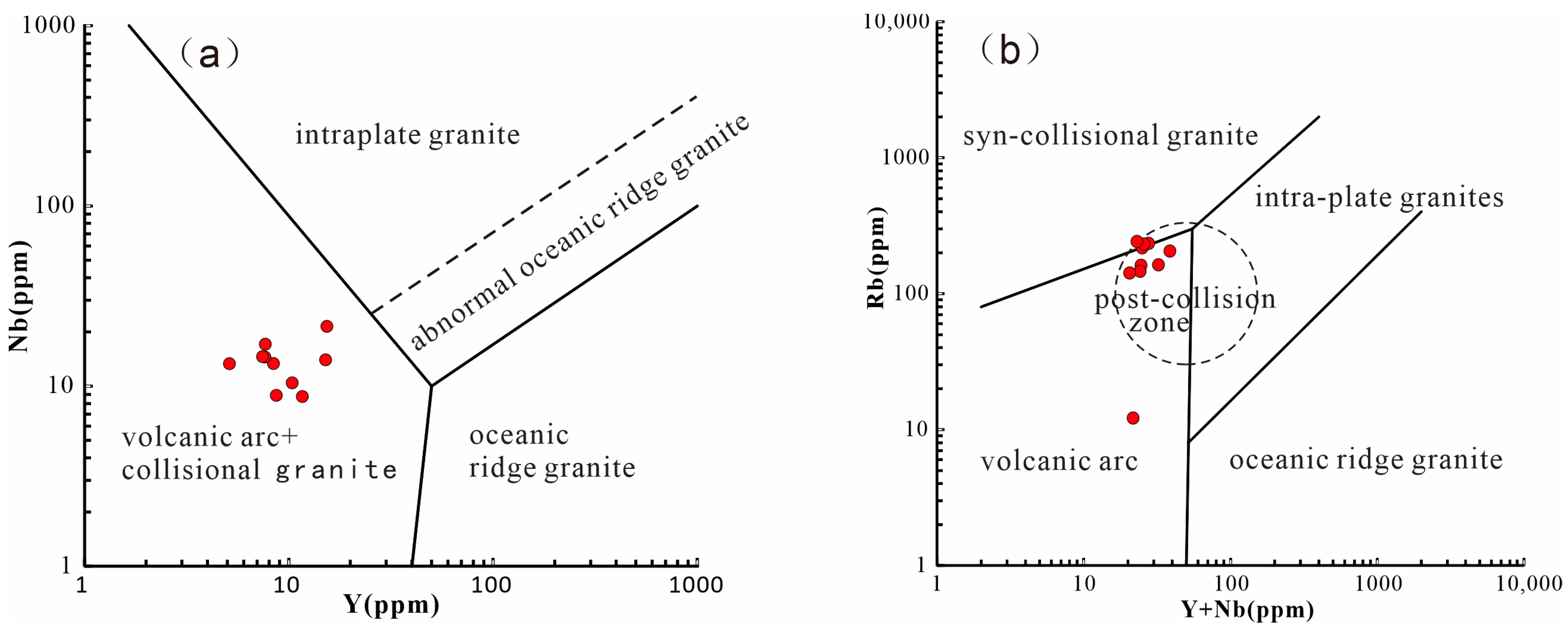
6. Conclusions
Author Contributions
Funding
Data Availability Statement
Conflicts of Interest
References
- Mi, L.; Tang, X.; Yang, H.; Yang, S.; Guo, S. Zircon U-Pb geochronology, Hf isotopes, and geochemistry constraints on the age and tectonic affinity of the basement granitoids from the Qiongdongnan Basin, northern South China Sea. Acta Oceanol. Sin. 2022, 42, 19–30. [Google Scholar] [CrossRef]
- Huang, J. P- and S-wave tomography of the Hainan and surrounding regions: Insight into the Hainan plume. Tectonophysics 2014, 633, 176–192. [Google Scholar] [CrossRef]
- Xu, D.; Kusiak, M.A.; Wang, Z.; Chen, H.; Bakun-Czubarow, N.; Wu, C.; Konečný, P.; Hollings, P. Microstructural observation and chemical dating on monazite from the Shilu Group, Hainan Province of South China: Implications for origin and evolution of the Shilu Fe–Co–Cu ore district. Lithos 2015, 216–217, 158–177. [Google Scholar] [CrossRef]
- Liu, X.; Chen, Y.; Wang, W.; Xia, M.; Hu, J.; Li, Y.; Hu, D.; Song, B. Carboniferous eclogite and garnet–omphacite granulite from northeastern Hainan Island, South China: Implications for the evolution of the eastern Palaeo-Tethys. J. Metamorph. Geol. 2020, 39, 101–132. [Google Scholar] [CrossRef]
- Liang, D.; Xu, G.; Gao, F.; Wen, L.; Jia, L.; Liu, L.; Jiao, D.; Yang, C.; Wu, S. Holocene sediment source analysis and paleoclimatic significance of core KZK01 from the eastern part of the Beibu Gulf. Front. Earth Sci. 2023, 11, 1192206. [Google Scholar] [CrossRef]
- Jiang, X.; Li, X. In situ zircon U–Pb and Hf–O isotopic results for ca. 73 Ma granite in Hainan Island: Implications for the termination of an Andean-type active continental margin in southeast China. J. Asian Earth Sci. 2014, 82, 32–46. [Google Scholar] [CrossRef]
- Jiang, X.; Dilek, Y.; Li, X. Cretaceous magmatic arc in Hainan and the peri-South China Sea as evidenced by geochemical fingerprinting of granitoids in the region. Geosci. Front. 2024, 15, 101866. [Google Scholar] [CrossRef]
- Shen, L.; Yu, J.; O’REilly, S.; Griffin, W.; Zhou, X. Subduction-related middle Permian to early Triassic magmatism in central Hainan Island, South China. Lithos 2018, 318–319, 158–175. [Google Scholar] [CrossRef]
- He, H.; Wang, Y.; Cawood, P.A.; Qian, X.; Zhang, Y.; Zhao, G. Permo–Triassic granitoids, Hainan Island, link to Paleotethyan not Paleopacific tectonics. GSA Bull. 2020, 132, 2067–2083. [Google Scholar] [CrossRef]
- Wang, R.; Zhao, G.; Wang, D.; Lu, J.; Xu, S. Differentiation and accumulation of fluids in A-type granites: Evidence from accessory mineral study. Chin. Sci. Bull. 2000, 45, 1609–1613. [Google Scholar] [CrossRef]
- Li, X.; Li, W.; Li, Z. Genesis type and tectonic significance of the Early Yanshan granites in the Nanling. Chin. Sci. Bull. 2007, 52, 981–991. (In Chinese) [Google Scholar]
- Zhang, X.; Wen, H.; Kuang, L.; Yan, D.; Lu, Z.; Hu, Z.; Xiong, F. Petrogenesis of Late Permian Alkaline Magmatic Rocks in Northern Hainan Island and Its Implications for the Tectonic Evolution of the Eastern Paleo-Tethys Ocean. Bull. Miner. Pet. Geochem. 2025, 50, 1–22. (In Chinese) [Google Scholar] [CrossRef]
- Li, Z.; Li, X. Formation of the 1300-km-wide intracontinental orogen and postorogenic magmatic province in Mesozoic South China: A flat-slab subduction model. Geology 2007, 35, 179–182. [Google Scholar] [CrossRef]
- Li, Z.; Li, X.; Chung, S.; Lo, C.; Xu, X.; Li, W. Magmatic switch-on and switch-off along the South China continental margin since the Permian: Transition from an Andean-type to a Western Pacific-type plate boundary. Tectonophysics 2012, 532–535, 271–290. [Google Scholar] [CrossRef]
- Zhou, Y.; Liang, X.; Kröner, A.; Cai, Y.; Shao, T.; Wen, S.; Jiang, Y.; Fu, J.; Wang, C.; Dong, C. Late Cretaceous lithospheric extension in SE China: Constraints from volcanic rocks in Hainan Island. Lithos 2015, 232, 100–110. [Google Scholar] [CrossRef]
- Sun, S.; Zhang, L.; Zhang, R.; Ding, X.; Zhu, H.; Zhang, Z.; Sun, W.-D. Mid–Late Cretaceous igneous activity in South China: The Qianjia example, Hainan Island. Int. Geol. Rev. 2017, 60, 1665–1683. [Google Scholar] [CrossRef]
- Li, J.; Zhang, Y.; Dong, S.; Johnston, S.T. Cretaceous tectonic evolution of South China: A preliminary synthesis. Earth-Sci. Rev. 2014, 134, 98–136. [Google Scholar] [CrossRef]
- Chen, Y.; Meng, J.; Liu, H.; Wang, C.; Tang, M.; Liu, T.; Zhao, Y. Detrital zircons record the evolution of the Cathaysian Coastal Mountains along the South China margin. Basin Res. 2021, 34, 688–701. [Google Scholar] [CrossRef]
- Meng, J.; Gilder, S.A.; Li, Y.; Chen, Y.; Zhang, C.; Zhou, Z.; Liu, T.; Zhao, Y.; Wang, Z.; Wang, C. Remagnetization Age and Mechanism of Cretaceous Sediments in Relation to Dyke Intrusion, Hainan Island: Tectonic Implications for South China and the Red River Fault. J. Geophys. Res. Solid Earth 2022, 127. [Google Scholar] [CrossRef]
- Liang, D.; Wu, S.; Xu, G.; Xia, C.; Gao, F.; Lin, Y.; Du, J.; Jia, L. Paleoenvironmental changes in the coastal zone of the northwest South China Sea during the last 13 kyr. Sci. Rep. 2023, 13, 1–13. [Google Scholar] [CrossRef]
- Liu, Y.; Mao, J.; Qiu, K.; Hu, J.; Wang, L.; Xu, D. Extensional Setting of Hainan Island in Mesoproterozoic: Evidence from Granitic Intrusions in the Baoban Group. Acta Geol. Sin. -Engl. Ed. 2022, 96, 1199–1212. [Google Scholar] [CrossRef]
- Xu, Y.; Liang, X.; Cawood, P.A.; Zi, J.; Zhang, H.; Liu, J.; Du, Y. Revisiting the paleogeographic position of South China in Gondwana by geochemistry and U Pb ages of detrital monazite grains from Cambrian sedimentary rocks. Lithos 2022, 430–431, 106879. [Google Scholar] [CrossRef]
- Hainan Geological Survey. Regional Geology of Hainan; Geological Publishing House: Beijing, China, 2017; pp. 1–250. (In Chinese)
- Yan, Q.; Metcalfe, I.; Shi, X. U-Pb isotope geochronology and geochemistry of granites from Hainan Island (northern South China Sea margin): Constraints on late Paleozoic-Mesozoic tectonic evolution. Gondwana Res. 2017, 49, 333–349. [Google Scholar] [CrossRef]
- Gao, G.; Xu, X.; Qu, T.; Gan, J.; Dang, W.; Zhou, X.; Liu, F. Petroleum Origins and Accumulation Patterns in the Weixinan Sag in the Beibu Gulf Basin, Using Subsag B as an Example. Acta Geol. Sin. -Engl. Ed. 2019, 94, 1515–1530. [Google Scholar] [CrossRef]
- Hu, Z.; Gao, S.; Liu, Y.; Hu, S.; Chen, H.; Yuan, H. Signal enhancement in laser ablation ICP-MS by addition of nitrogen in the central channel gas. J. Anal. At. Spectrom. 2008, 23, 1093–1101. [Google Scholar] [CrossRef]
- Liu, Y.; Gao, S.; Hu, Z.; Gao, C.; Zong, K.; Wang, D. Continental and Oceanic Crust Recycling-induced Melt-Peridotite Interactions in the Trans-North China Orogen: U-Pb Dating, Hf Isotopes and Trace Elements in Zircons from Mantle Xenoliths. J. Pet. 2009, 51, 537–571. [Google Scholar] [CrossRef]
- Lin, Y.; Liang, D.; Hu, Z.; Yuan, Q.; Lv, Z.; Guan, J. Petrogenesis and geotectonic significance of magnesian andesite in the Nangunyuan area, northern Hainan Island, China. Front. Earth Sci. 2025, 13, 1613531. [Google Scholar] [CrossRef]
- Li, Z.-X.; Li, X.-H.; Zhou, H.; Kinny, P.D. Grenvillian continental collision in south China: New SHRIMP U-Pb zircon results and implications for the configuration of Rodinia. Geology 2002, 30, 163–166. [Google Scholar] [CrossRef]
- Wang, C.; Wei, C.; Yun, P.; Lv, C.; Lv, Z.; Meng, Z. Zircon U-Pb age, geochemistry and geological significance of Shunzuo granite in Wuzhishan area, Hainan Island. Geol. Bull. China. 2019, 38, 1352–1361. (In Chinese) [Google Scholar]
- Middlemost, E.A.K. Naming materials in the magma/igneous rock system. Earth-Sci. Rev. 1994, 37, 215–224. [Google Scholar] [CrossRef]
- Rickwood, P.C. Boundary lines within petrologic diagrams which use oxides of major and minor elements. Lithos 1989, 22, 247–263. [Google Scholar] [CrossRef]
- Lin, W.; Peng, L. The estimation of Fe3+ and Fe2+ contents in amphibole and biotite from EMPA Data. J. Chang. Univ. Earth Sci. 1994, 24, 155–162. (In Chinese) [Google Scholar]
- Foster, M.; Nolan, T. Interpretation of the composition of trioctahedral micas. US Geol. Surv. Prof. Paper 1960, 354B, 11–49. [Google Scholar]
- Wang, J.; Wang, Y.; Hong, W.; Lan, C.; Fan, J.; Long, X. Middle Paleoproterozoic tectonic evolution of the North China Craton: Constraints from the A-type granites in the Wutai area. Precambrian Res. 2025, 419, 107711. [Google Scholar] [CrossRef]
- Khashaba, S.M.A.; El-Shibiny, N.; Hassan, S.M.; Drüppel, K.; Azer, M.K. Remote sensing and geochemistry of A-type granites, North Arabian-Nubian Shield: Insights into the origin and evolution of the granitic suites and processes responsible for rare metals enrichment. Ore Geol. Rev. 2024, 175, 106391. [Google Scholar] [CrossRef]
- Chen, L.; Li, Z.; Pei, X.; Zhao, S.; Wang, M.; Zhou, H.; Pei, L.; Chen, Y.; Ji, S.; Hou, W. Petrogenesis and tectonic significance of the late Middle Triassic I-type granite in the eastern section of the North Qilian tectonic belt: Constraints on the initiation of post-collision between North China Block and South China Block. Lithos 2025, 508–509, 108081. [Google Scholar] [CrossRef]
- Xi, Z.; Zhang, Y.; Liu, Z.; Li, H.; Liu, F. Petrogenesis and geodynamics of the Dashenshan I-type granite and its implications for the Triassic tectonic evolution of the South China Block. Acta Geochim. 2024, 44, 673–699. [Google Scholar] [CrossRef]
- Qin, Z.-W.; Wu, Y.-B.; Siebel, W.; Wang, H.; Fu, J.-M.; Lu, Y.-Y.; Shan, L.; Yu, Y.-S. Source nature and magma evolution of I-type granites from the North Qinling orogen, China, revealed by zircon morphology and grain-scale variations in Hf O isotope composition. Lithos 2022, 428–429, 106819. [Google Scholar] [CrossRef]
- Li, X.; Li, Z.; Li, W.; Liu, Y.; Yuan, C.; Wei, G.; Qi, C. U–Pb zircon, geochemical and Sr–Nd–Hf isotopic constraints on age and origin of Jurassic I- and A-type granites from central Guangdong, SE China: A major igneous event in response to foundering of a subducted flat-slab? Lithos 2007, 96, 186–204. [Google Scholar] [CrossRef]
- Zhu, C.; Yang, G.; Wen, H.; Zhang, Y.; Zhou, Z.; Li, Z.; Du, S.; Zhang, L.; Chen, X.; Luais, B. Cadmium isotope fractionation in a S-type granite related large magmatic–hydrothermal system. Gondwana Res. 2024, 131, 363–373. [Google Scholar] [CrossRef]
- Ma, H.; Cai, P.; Lian, D.; Yang, J. Grenvillian S-type granites in the North Qaidam orogenic belt, NW China: Implications for the geodynamic evolution of the Rodinia supercontinent. Precambrian Res. 2025, 427, 107867. [Google Scholar] [CrossRef]
- Hussain, A.; Zhao, K.-D.; Robinson, D.M.; Moradi, S.; Sajid, M.; Rehman, H.U.; Li, Q.; Hussain, S.M.; Ali, R. Petrogenesis and tectonic implications of Paleozoic S-type granitic gneisses of Nanga Parbat Syntaxis, North Pakistan. Lithos 2025, 502–503, 108008. [Google Scholar] [CrossRef]
- Whalen, J.B.; Currie, K.L.; Chappell, B.W. A-type granites: Geochemical characteristics, discrimination and petrogenesis. Contrib. Mineral. Petrol. 1987, 95, 407–419. [Google Scholar] [CrossRef]
- Chatterjee, S.; Mukherjee, S.; Sanyal, S.; Sengupta, P. Petrogenesis of magmatic charnockite-biotite granite suite from parts of the Chotanagpur Granite Gneissic Complex (CGGC), eastern Indian shield: Implication for the break down of the Columbia Supercontinent. Lithos 2024, 488–489, 107802. [Google Scholar] [CrossRef]
- Zhang, T.; Xia, Q.; Yang, X.; Zhao, Z.; Sun, J.; Zha, X.; Lu, Y. The petrogenesis and metallogenesis of the ore-forming granites in the Tongmukeng Sn deposit, Jiangnan Orogenic Belt, South China. Ore Geol. Rev. 2024, 168, 106016. [Google Scholar] [CrossRef]
- Röper, T.; Bussweiler, Y.; Hellers, M.; Möckel, F.; Wombacher, F.; Münker, C. A sheared garnet peridotite mantle xenolith from the Delitzsch Carbonatite Complex, Germany—Evidence for thickened Cretaceous lithosphere beneath Central Europe. Lithos 2025, 512–513, 108156. [Google Scholar] [CrossRef]
- Saleh, G.M.; Kamar, M.S.; Khaleal, F.M.; Azer, M.K.; Nasr, T.; Lasheen, E.S.R. Petrogenesis and tectonic evolution of tourmaline- bearing leucogranites, Sikait area, South Eastern Desert of Egypt utilizing mineralogical and bulk rock analysis. Sci. Rep. 2025, 15, 1–25. [Google Scholar] [CrossRef]
- Schmitt, F.; Marks, M.A.; Siegel, M.; Henzler, M.; Zaitsev, A.N.; Markl, G. Nephelinites from Burko volcano (Tanzania) record the phase relations among perovskite, magnetite, titanite and andradite in evolved alkaline and silica-undersaturated systems. Geochemistry 2024, 84, 126211. [Google Scholar] [CrossRef]
- Spencer, L.; Albert, C.; Williams, H.; Nebel, O.; Parkinson, I.; Smithies, R.; Bruno, H.; Fowler, M.; Moreira, H.; Lissenberg, C.; et al. Tracing hydrous eclogite melts in the source of sanukitoids. Earth Planet. Sci. Lett. 2024, 648, 119067. [Google Scholar] [CrossRef]
- Xing, H.; Pei, J.; Song, Z.; Liu, G.; Wu, W.; Wen, J.; Zhang, X.; Xu, Z.; Yang, X. Middle to Late Permian adakitic granites in the Xiari complex, North China: Insights into the final closure of the eastern Paleo-Asian ocean. Lithos 2024, 480–481, 107664. [Google Scholar] [CrossRef]
- Qian, L.; Xie, J.; Huang, S.; Ge, L.; Zhang, X.; Li, Q.; Liu, J.; Yan, J.; Sun, W. Petrogenesis of Early Cretaceous granitoids in Liyang volcanic basin, eastern China: Geodynamic implications for Paleo-Pacific slab rollback. Tectonophys 2022, 838, 229521. [Google Scholar] [CrossRef]
- Ao, W.; Zhao, Y.; Zhang, Y.; Zhai, M.; Zhang, H.; Zhang, R.; Wang, Q.; Sun, Y. The Neoproterozoic magmatism in the northern margin of the Yangtze Block: Insights from Neoproterozoic (950–706 Ma) gabbroic-granitoid rocks of the Hannan Complex. Precambrian Res. 2019, 333, 105442. [Google Scholar] [CrossRef]
- Niu, P.; Jiang, S. Petrogenesis of the Late Mesozoic Qijinfeng Granite Complex in the Tongbai orogen: Geochronological, geochemical and Sr-Nd-Pb-Hf isotope evidence. Lithos 2020, 356–357, 105290. [Google Scholar] [CrossRef]
- Zhou, Z. The origin of intrusive mass in Fengshandong, Hubei Province. Acta Petrol. Sin. 1986, 2, 61–72. (In Chinese) [Google Scholar]
- Abdel-Rahman, A.-F.M. Nature of Biotites from Alkaline, Calc-alkaline, and Peraluminous Magmas. J. Pet. 1994, 35, 525–541. [Google Scholar] [CrossRef]
- Liu, A.; Wang, Q.; Zhu, D.; A Cawood, P.; Xia, Y.; Li, S.; Liu, S.; Huang, F.; Liu, L.; Zhao, Z.; et al. Temporal and Spatial Variations of Enriched Source Components in Linzizong Volcanic Succession, Tibet, and Implications for the India–Asia Collision. J. Pet. 2021, 63, 1–30. [Google Scholar] [CrossRef]
- Xu, J.; Chen, S. Petrogenesis of adakitic rocks unrelated to slab melting and adakitic porphyries associated with Cu mineralization. Lithos 2023, 458–459, 107351. [Google Scholar] [CrossRef]
- Luchitskaya, M.V. The Composition, Petrogenesis, and Geodynamic Setting of Adakite Magmatism: An Overview. Geotectonics 2022, 56, 486–519. [Google Scholar] [CrossRef]
- Feng, Y.; Yang, J.; Sun, J.; Zhang, J. Material records for Mesozoic destruction of the North China Craton by subduction of the Paleo-Pacific slab. Sci. China Earth Sci. 2020, 63, 690–700. [Google Scholar] [CrossRef]
- Kaygusuz, A.; Siebel, W.; Şen, C.; Satir, M. Petrochemistry and petrology of I-type granitoids in an arc setting: The composite Torul pluton, Eastern Pontides, NE Turkey. Int. J. Earth Sci. 2007, 97, 739–764. [Google Scholar] [CrossRef]
- Sun, J.; Sun, F.; Ren, L.; Jin, R.; He, X.; Li, X.; Liu, C. Compositional characteristics and petrogenetic and metallogenic significance of biotites from Caoshan granite rock mass in Linjiang area, Jilin Province. World Geol. 2018, 37, 458–476. (In Chinese) [Google Scholar]
- Wang, Y.; Qian, X.; Cawood, P.A.; Liu, H.; Feng, Q.; Zhao, G.; Zhang, Y.; He, H.; Zhang, P. Closure of the East Paleotethyan Ocean and amalgamation of the Eastern Cimmerian and Southeast Asia continental fragments. Earth-Sci. Rev. 2018, 186, 195–230. [Google Scholar] [CrossRef]
- Liu, L.; Xu, X.; Xia, Y. Cretaceous Pacific plate movement beneath SE China: Evidence from episodic volcanism and related intrusions. Tectonophysics 2014, 614, 170–184. [Google Scholar] [CrossRef]
- Ma, X.; Zhao, Z.; Cao, W.; Huang, H.; Xiong, F.; Cawood, T.; Li, H. Mesoscopic and microscopic magmatic structures in the Quxu batholith of the Gangdese belt, Southern Tibet: Implications for multiple hybridization processes. Front. Earth Sci. 2021, 9, 772374. [Google Scholar] [CrossRef]
- Wu, F.; Li, X.; Yang, J.; Zhen, Y. Discussions on the petrogenesis of granites. Acta Petrol. Sin. 2007, 23, 1217–1238. (In Chinese) [Google Scholar]
- Li, P.; Liu, X.; Liu, L. Petrogenesis of Late Cretaceous Muscovite-Bearing Peraluminous Granites in the Youjiang Basin, South China Block: Implications for Tin Mineralization. Minerals 2023, 13, 1206. [Google Scholar] [CrossRef]
- Qin, J.; Wang, D.; Chen, Y. Geochemical and Sr–Nd–Pb isotopic characteristics of basalt from eastern Hunan Province: New insight for the Late Cretaceous tectonic dynamic mechanism in South China. Geol. J. 2020, 55, 8141–8168. [Google Scholar] [CrossRef]
- Zhao, X.; Jiang, Y.; Xing, G.; Yu, M.; Mao, J.; Yu, S. Newly discovered Late Cretaceous adakites in South Fujian Province: Implications for the late Mesozoic tectonic evolution of Southeast China. Isl. Arc 2018, 27, e12236. [Google Scholar] [CrossRef]
- Batchelor, R.A.; Bowden, P. Petrogenetic interpretation of granitoid rock series using multicationic parameters. Chem. Geol. 1985, 48, 43–55. [Google Scholar] [CrossRef]
- Pearce, J.A.; Harris, N.B.W.; Tindle, A.G. Trace Element Discrimination Diagrams for the Tectonic Interpretation of Granitic Rocks. J. Pet. 1984, 25, 956–983. [Google Scholar] [CrossRef]
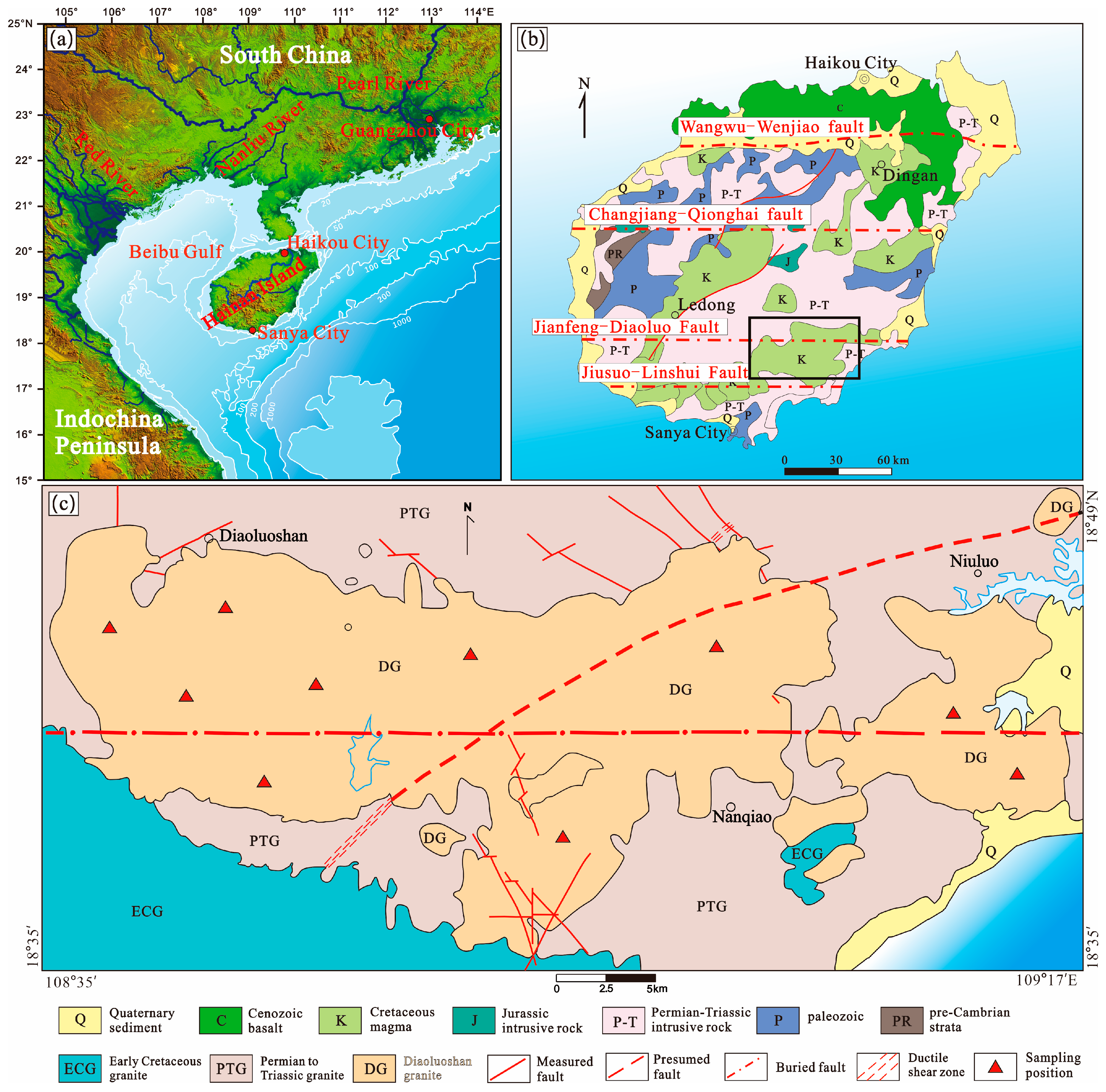


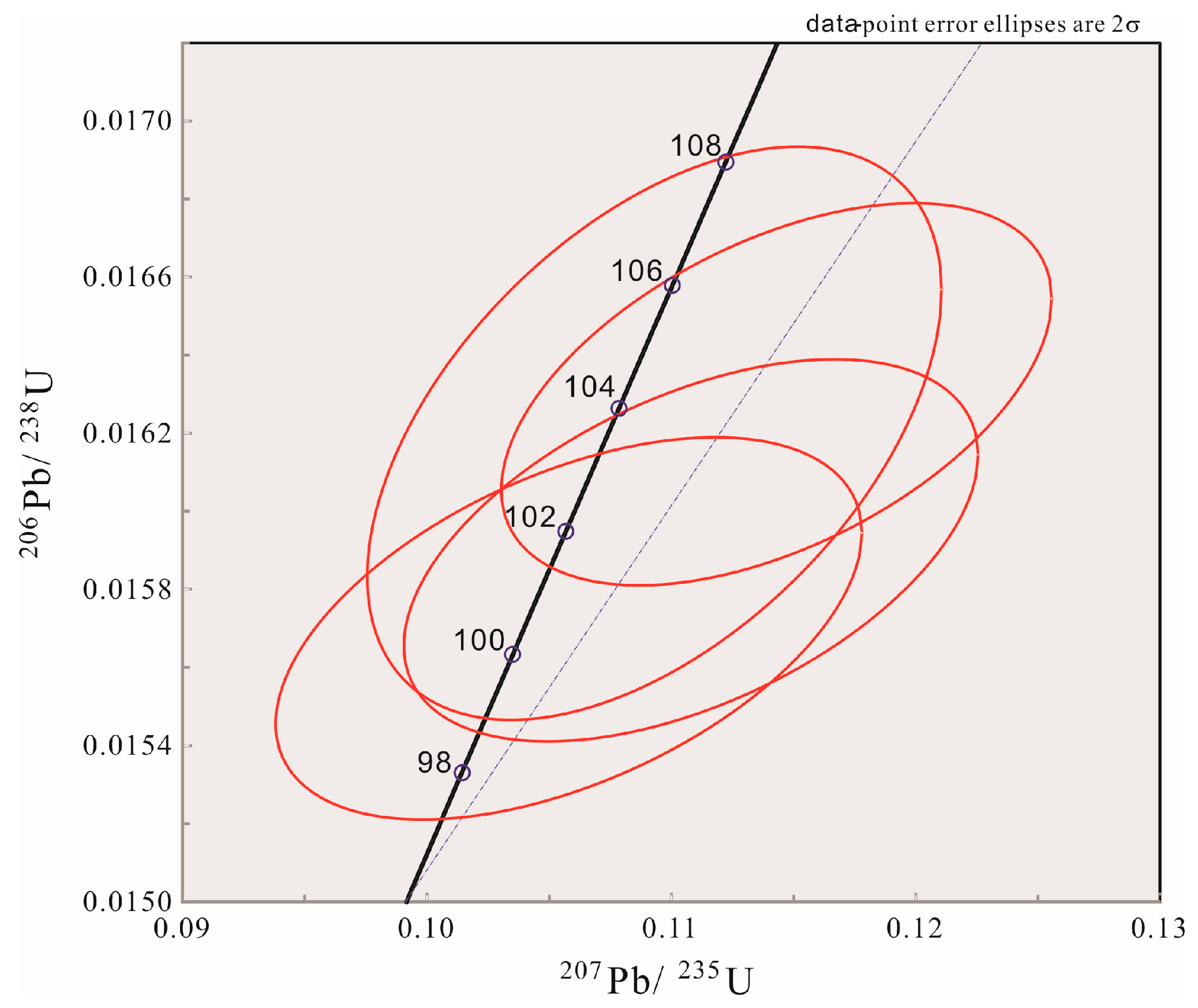
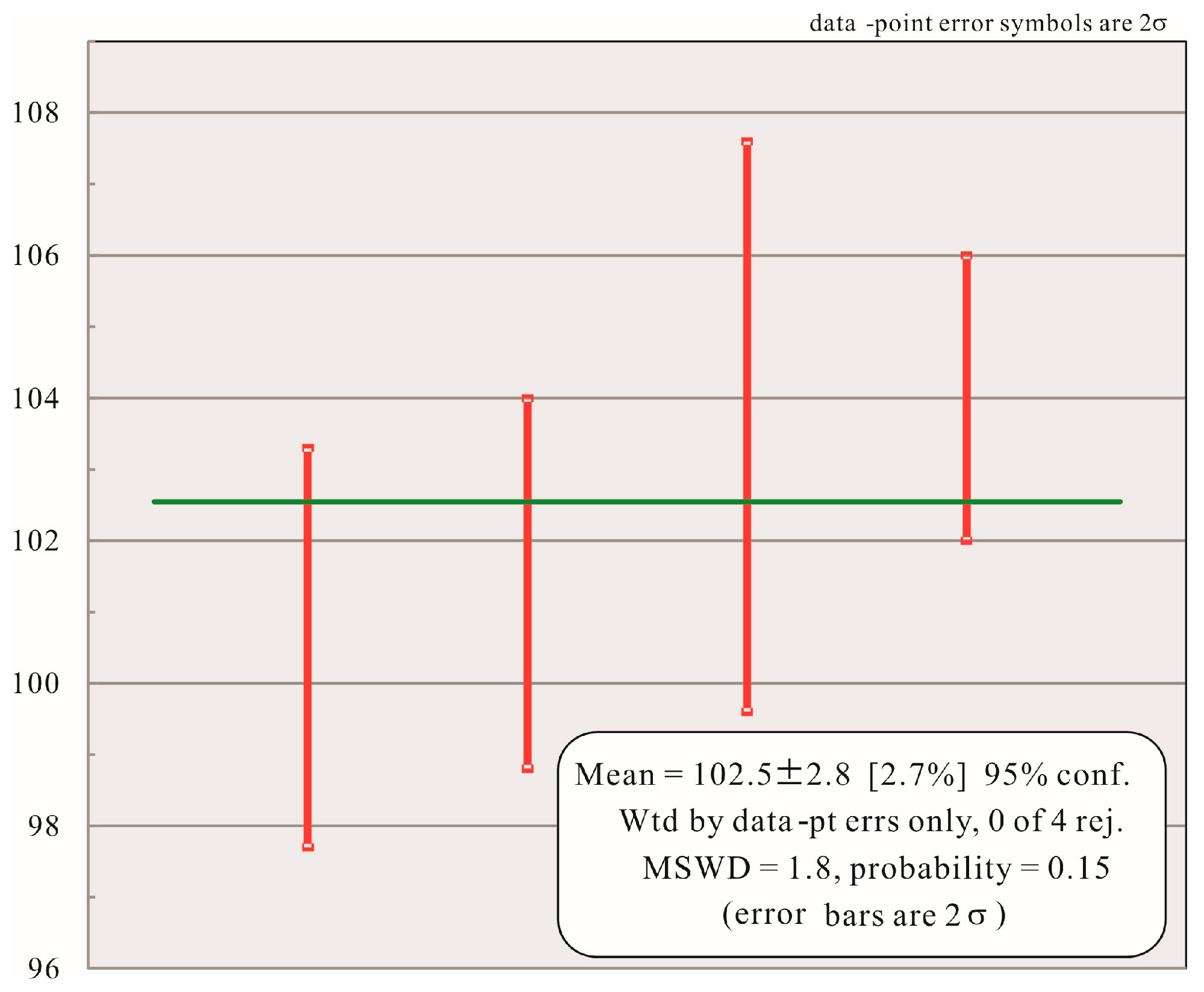

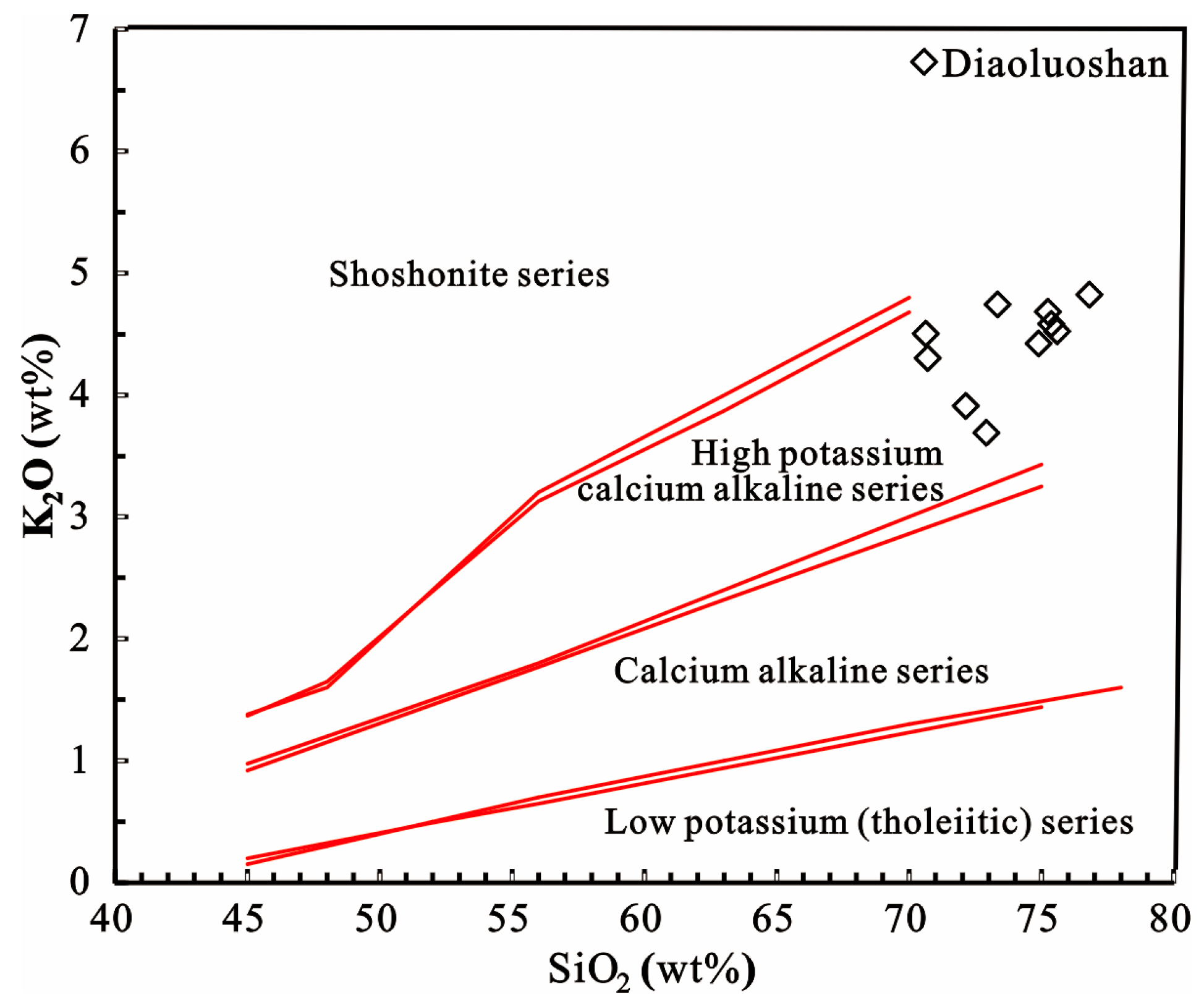

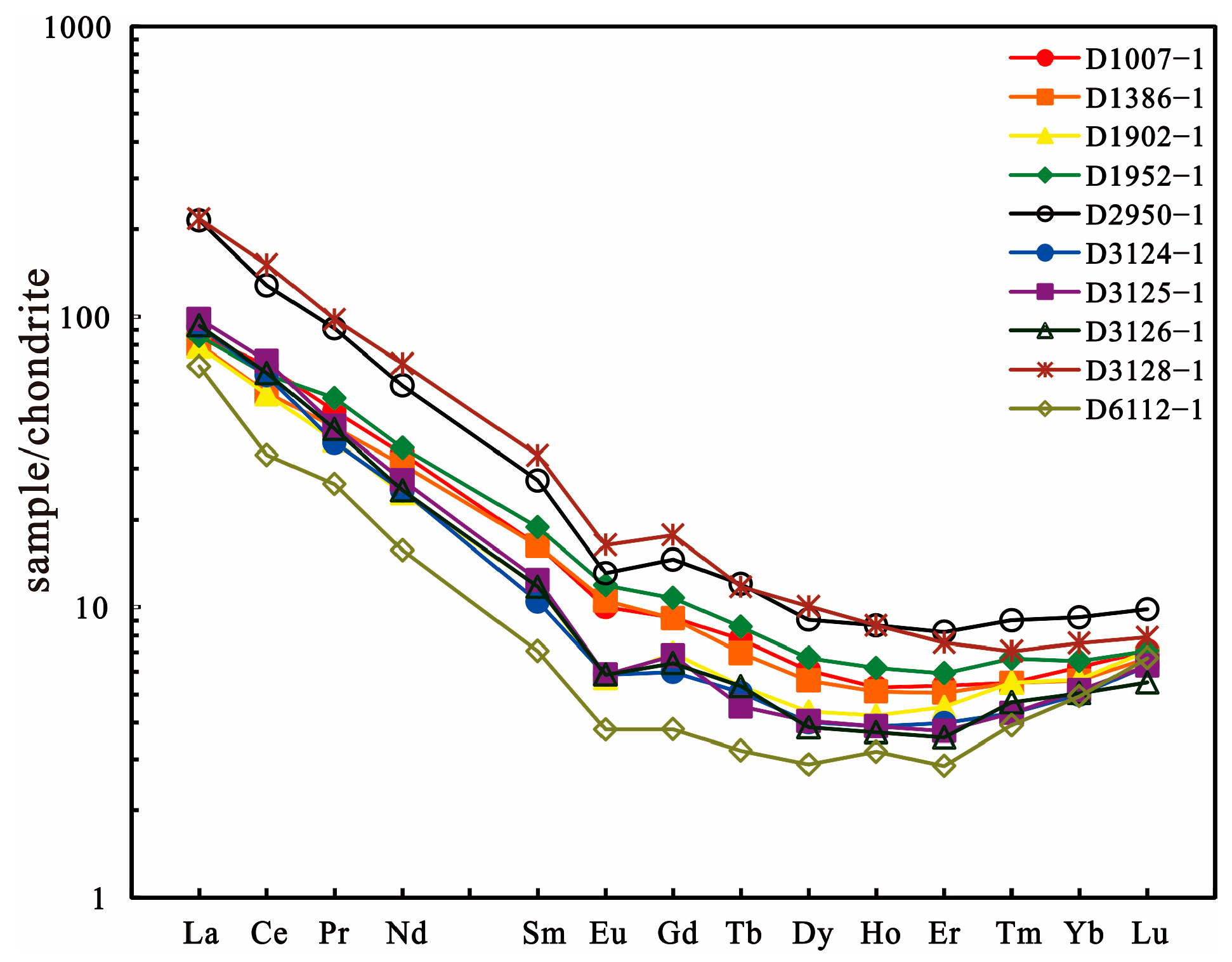
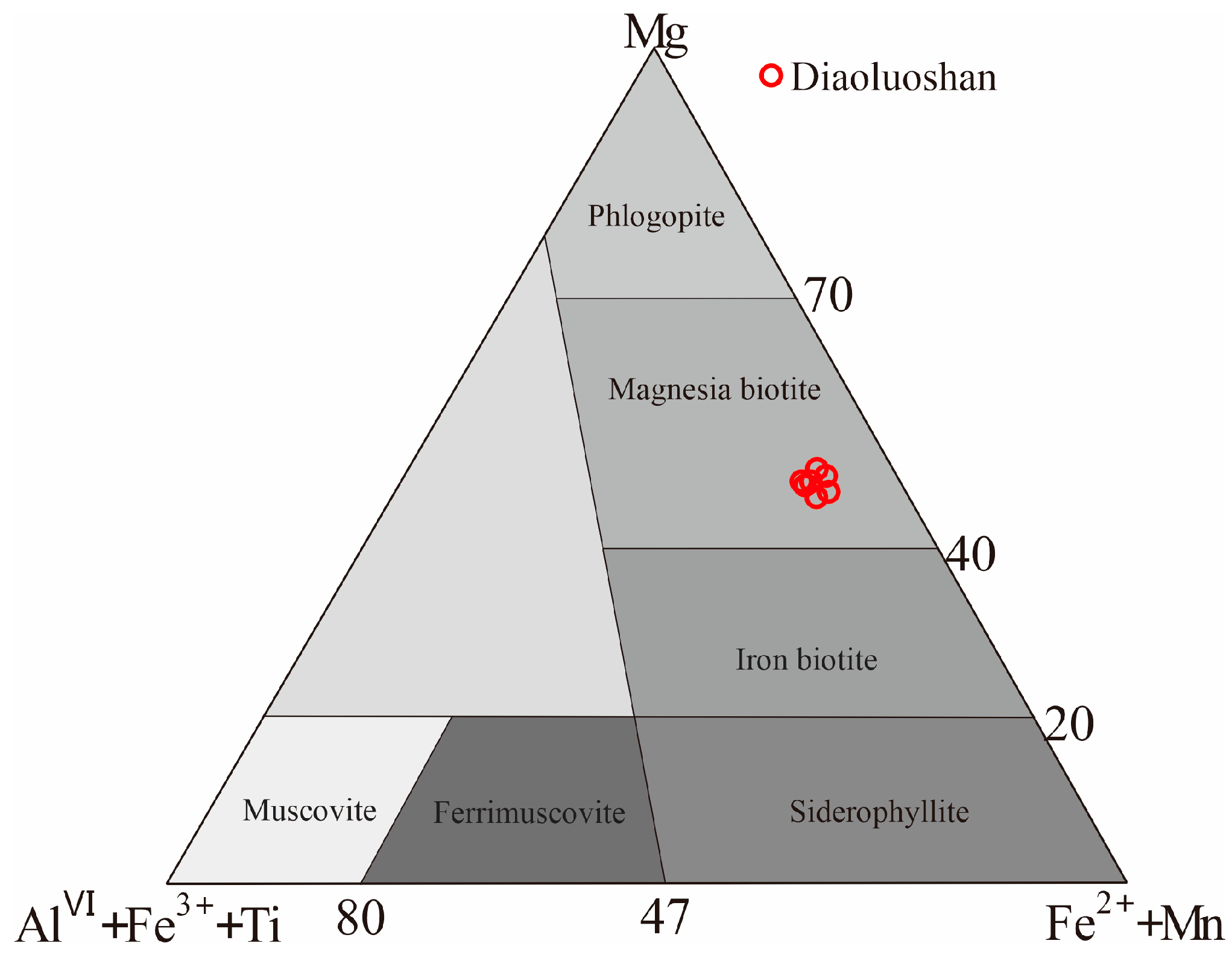

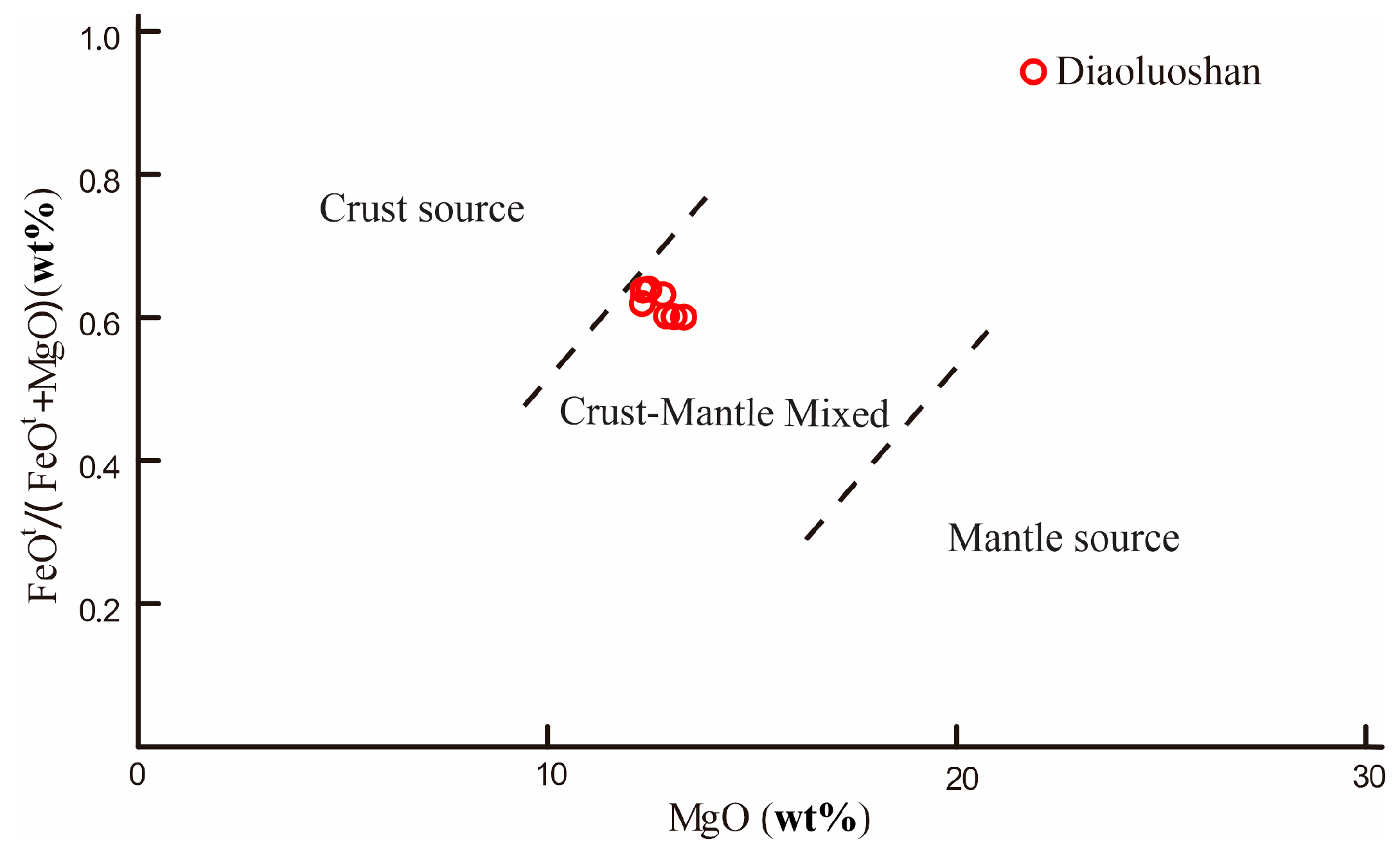
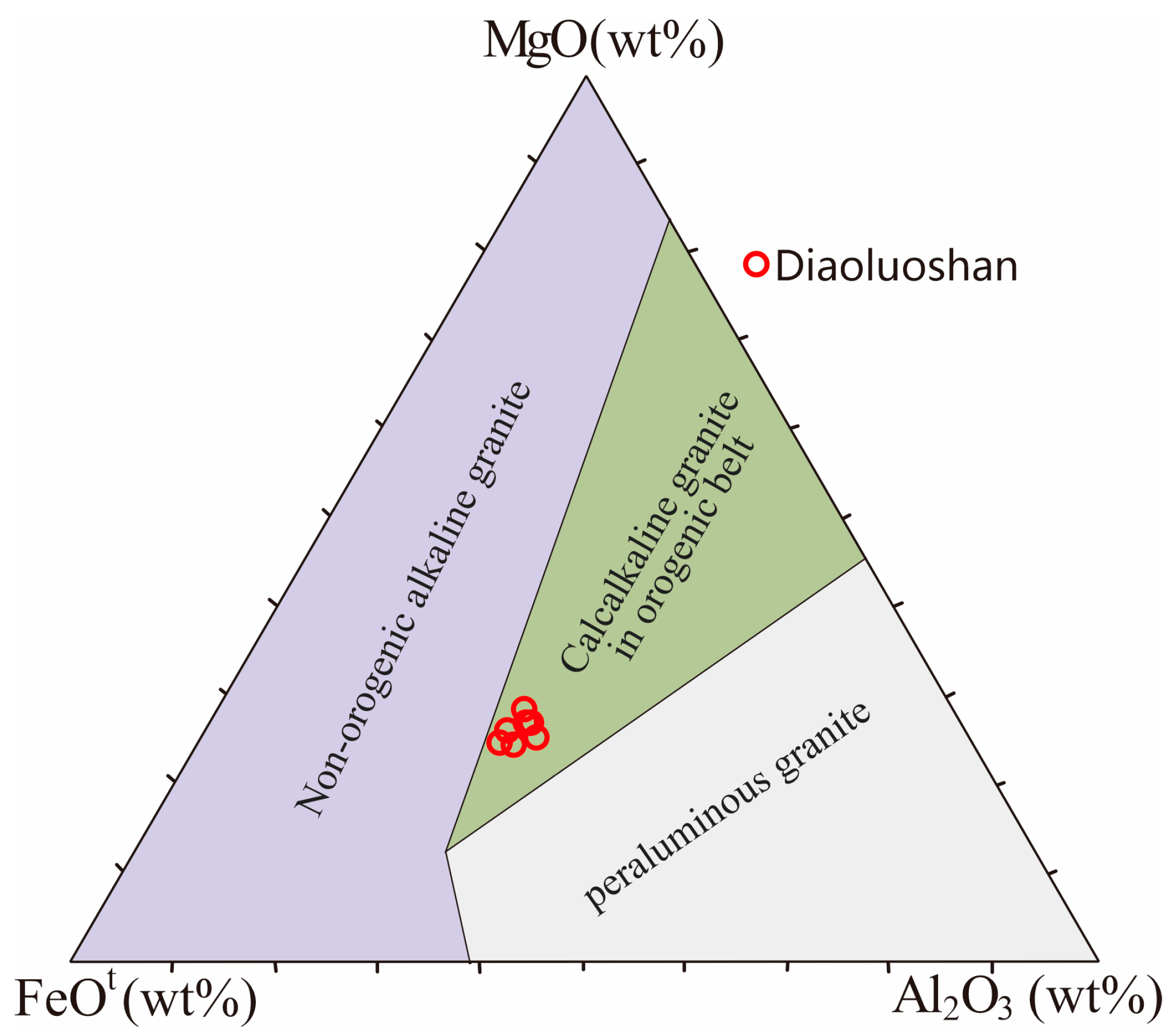
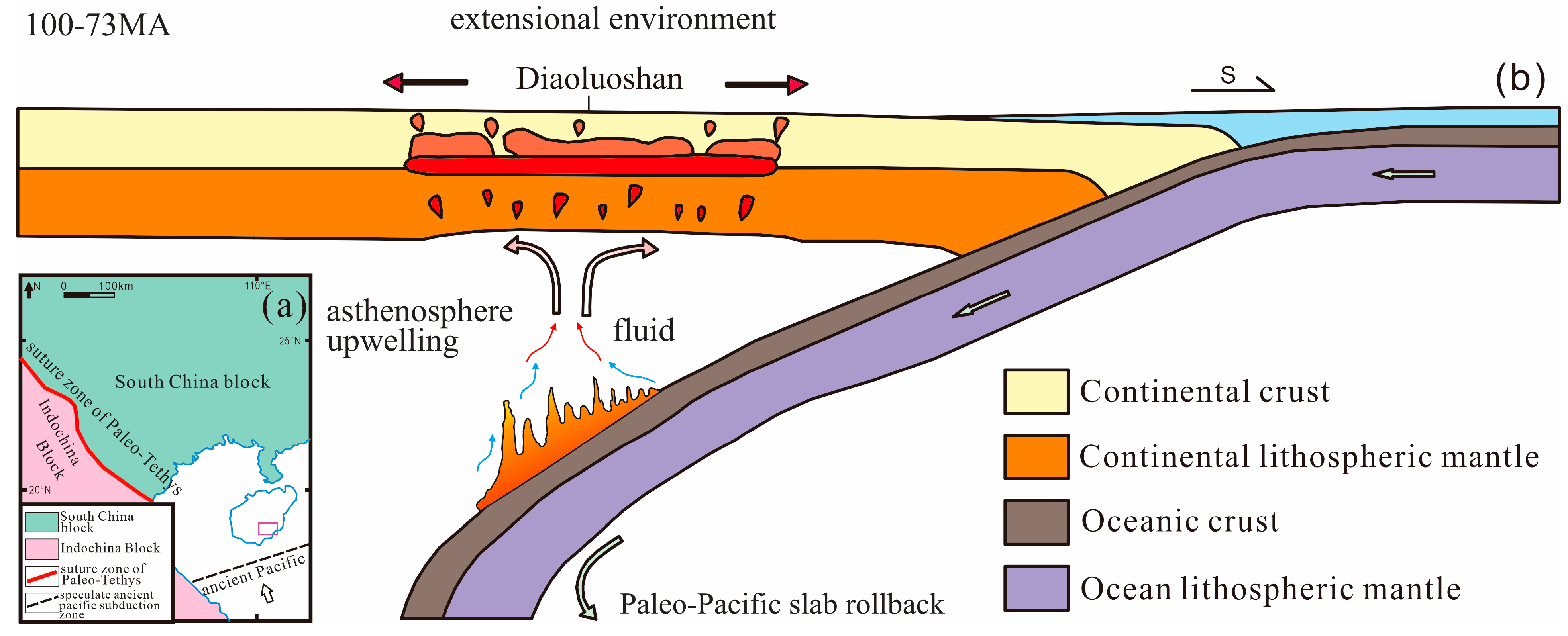
| Test Spot Number | Content (ppm) | Th/U | Isotope Ratio | Age (Ma) | ||||||||
|---|---|---|---|---|---|---|---|---|---|---|---|---|
| Th | U | 207Pb/235U | 1σ | 206Pb/238U | 1σ | 207Pb/235U | 1σ | 206Pb/238U | 1σ | Concordance | ||
| 1 | 450 | 426 | 1.06 | 0.1093 | 0.0048 | 0.0162 | 0.0003 | 105.3 | 4.4 | 103.6 | 2.0 | 98% |
| 2 | 2566 | 2156 | 1.19 | 0.0985 | 0.0018 | 0.0147 | 0.0001 | 95 | 2 | 93.8 | 0.8 | 98% |
| 3 | 185 | 267 | 0.69 | 0.0936 | 0.0042 | 0.0147 | 0.0002 | 90.9 | 3.9 | 94.3 | 1.3 | 96% |
| 4 | 856 | 1194 | 0.72 | 0.1045 | 0.0026 | 0.0148 | 0.0002 | 101.0 | 2.4 | 94.4 | 1.1 | 93% |
| 5 | 230 | 196 | 1.17 | 0.1108 | 0.0048 | 0.0159 | 0.0002 | 107 | 4 | 101.4 | 1.3 | 94% |
| 6 | 290 | 328 | 0.88 | 0.1043 | 0.0045 | 0.0155 | 0.0002 | 101 | 4 | 99.0 | 1 | 98% |
| 7 | 417 | 406 | 1.03 | 0.0962 | 0.0137 | 0.0147 | 0.0002 | 93.3 | 12.7 | 94.0 | 1.3 | 99% |
| 8 | 326 | 283 | 1.15 | 0.1025 | 0.0043 | 0.0155 | 0.0002 | 99.1 | 4.0 | 99.3 | 1.2 | 99% |
| 9 | 1360 | 3006 | 0.45 | 0.0941 | 0.0016 | 0.0143 | 0.0002 | 91.3 | 1.5 | 91.6 | 1.0 | 99% |
| 10 | 2020 | 2334 | 0.87 | 0.0972 | 0.0019 | 0.0153 | 0.0001 | 94.2 | 1.8 | 97.6 | 0.7 | 96% |
| 11 | 241 | 215 | 1.12 | 0.1037 | 0.0044 | 0.0153 | 0.0002 | 100.2 | 4.1 | 97.8 | 1.2 | 97% |
| 12 | 227 | 178 | 1.27 | 0.1058 | 0.0049 | 0.0157 | 0.0002 | 102 | 5 | 100.5 | 1.4 | 98% |
| 13 | 430 | 201 | 2.13 | 0.1143 | 0.0046 | 0.0163 | 0.0002 | 110 | 4 | 104 | 1 | 94% |
| Sample | SiO2 | TiO2 | Al2O3 | Fe2O3 | FeO | MnO | MgO | CaO | Na2O | K2O | P2O5 | DI | A/CNK | SI | σ | AR | Total Alkali | NKA | Na2O/K2O | FeOt/MgO | K2O + Na2O |
|---|---|---|---|---|---|---|---|---|---|---|---|---|---|---|---|---|---|---|---|---|---|
| D1007-1 | 72.14 | 0.29 | 13.73 | 0.40 | 2.13 | 0.06 | 0.76 | 1.95 | 3.69 | 3.91 | 0.08 | 84.40 | 0.99 | 6.98 | 1.98 | 2.88 | 7.60 | 0.75 | 0.94 | 3.28 | 7.60 |
| D1386-1 | 72.91 | 0.25 | 13.83 | 0.70 | 1.00 | 0.05 | 0.68 | 2.09 | 3.83 | 3.69 | 0.07 | 85.93 | 0.98 | 6.87 | 1.88 | 2.79 | 7.52 | 0.74 | 1.04 | 2.40 | 7.52 |
| D1902-1 | 75.60 | 0.15 | 12.78 | 0.48 | 0.62 | 0.05 | 0.32 | 1.25 | 3.61 | 4.52 | 0.03 | 91.94 | 0.98 | 3.35 | 2.02 | 3.76 | 8.13 | 0.85 | 0.80 | 3.29 | 8.13 |
| D1952-1 | 70.64 | 0.29 | 14.45 | 1.04 | 1.13 | 0.07 | 0.79 | 2.11 | 3.95 | 4.50 | 0.08 | 85.74 | 0.95 | 6.92 | 2.57 | 3.08 | 8.45 | 0.79 | 0.88 | 2.62 | 8.45 |
| D2950-1 | 73.35 | 0.27 | 13.59 | 0.73 | 1.00 | 0.06 | 0.48 | 1.39 | 3.64 | 4.74 | 0.07 | 89.62 | 1.00 | 4.53 | 2.31 | 3.54 | 8.38 | 0.82 | 0.77 | 3.45 | 8.38 |
| D3124-1 | 75.38 | 0.12 | 12.80 | 0.30 | 1.48 | 0.05 | 0.16 | 0.94 | 3.45 | 4.58 | 0.01 | 91.54 | 1.04 | 1.60 | 1.99 | 3.81 | 8.03 | 0.83 | 0.75 | 10.94 | 8.03 |
| D3125-1 | 74.90 | 0.15 | 12.85 | 0.13 | 1.88 | 0.06 | 0.22 | 0.92 | 3.44 | 4.42 | 0.03 | 90.54 | 1.06 | 2.18 | 1.93 | 3.66 | 7.86 | 0.81 | 0.78 | 9.08 | 7.86 |
| D3126-1 | 75.24 | 0.14 | 13.01 | 0.09 | 1.88 | 0.05 | 0.24 | 0.81 | 3.41 | 4.68 | 0.03 | 91.09 | 1.07 | 2.33 | 2.03 | 3.82 | 8.09 | 0.82 | 0.73 | 8.17 | 8.09 |
| D3128-1 | 70.70 | 0.35 | 14.34 | 0.76 | 2.27 | 0.06 | 0.72 | 2.06 | 3.43 | 4.30 | 0.13 | 83.07 | 1.02 | 6.27 | 2.15 | 2.78 | 7.73 | 0.72 | 0.80 | 4.10 | 7.73 |
| D6112-1 | 76.81 | 0.09 | 12.61 | 0.54 | 0.20 | 0.03 | 0.11 | 0.85 | 3.34 | 4.82 | 0.01 | 94.21 | 1.03 | 1.22 | 1.97 | 4.08 | 8.16 | 0.85 | 0.69 | 6.24 | 8.16 |
| Sample | Rb | Ba | Sr | Th | U | Ta | Nb | Pb | Zr | Hf | Ga | Zn | Ni | V | Cr | Cs | Co | Li | Y | Au | Rb/Sr |
|---|---|---|---|---|---|---|---|---|---|---|---|---|---|---|---|---|---|---|---|---|---|
| D1007-1 | 116.0 | 445.0 | 355.0 | 11.3 | 4.3 | 0.8 | 8.8 | 25.2 | 97.0 | 3.5 | 15.2 | 37.0 | 3.3 | 23.9 | 6.5 | 2.5 | 3.5 | 31.0 | 10.5 | 0.1 | 0.3 |
| D1386-1 | 115.0 | 456.0 | 384.0 | 10.8 | 3.0 | 0.6 | 8.97 | 26.5 | 79.0 | 3.2 | 16.5 | 39.5 | 3.0 | 26.3 | 2.3 | 3.1 | 3.9 | 36.1 | 7.8 | 0.5 | 0.3 |
| D1902-1 | 15.0 | 231.0 | 165.0 | 13.0 | 6.8 | 0.7 | 13.2 | 35.0 | 74.8 | 3.2 | 16.3 | 32.7 | 2.3 | 14.0 | 0.8 | 4.5 | 2.3 | 37.3 | 7.1 | 0.4 | 1.0 |
| D1952-1 | 139.0 | 726.0 | 394.0 | 14.5 | 9.5 | 0.7 | 10.6 | 28.8 | 102.0 | 4.5 | 16.7 | 50.5 | 3.7 | 31.5 | 3.3 | 2.4 | 4.5 | 42.5 | 9.5 | 0.5 | 0.4 |
| D2950-1 | 175.0 | 412.0 | 284.0 | 25.6 | 4.1 | 1.5 | 19.6 | 28.7 | 146.0 | 5.3 | 17.3 | 41.4 | 2.2 | 18.7 | 2.4 | 5.5 | 2.3 | 34.6 | 13.6 | 0.4 | 0.6 |
| D3124-1 | 199.0 | 139.1 | 145.2 | 17.3 | 6.9 | 1.1 | 12.4 | 35.3 | 68.5 | 2.9 | 12.9 | 24.5 | 4.4 | 10.1 | 10.5 | 2.1 | 1.4 | 199.0 | 7.9 | 3.0 | 1.4 |
| D3125-1 | 213.0 | 204.7 | 159.6 | 19.4 | 7.1 | 1.1 | 15.0 | 39.9 | 78.3 | 3.4 | 14.4 | 28.0 | 4.4 | 12.3 | 10.2 | 2.5 | 1.8 | 213.0 | 7.2 | 1.2 | 1.3 |
| D3126-1 | 223.0 | 187.2 | 157.0 | 18.2 | 7.8 | 1.1 | 13.6 | 40.9 | 78.0 | 3.3 | 13.3 | 26.6 | 18.1 | 11.8 | 40.2 | 2.1 | 1.4 | 12.9 | 6.9 | 0.4 | 1.4 |
| D3128-1 | 136.0 | 581.7 | 406.3 | 17.8 | 3.3 | 1.0 | 13.1 | 31.0 | 141.0 | 4.6 | 17.8 | 45.2 | 10.7 | 33.4 | 26.1 | 1.8 | 4.0 | 33.6 | 13.3 | 0.5 | 0.3 |
| D6112-1 | 230.0 | 38.3 | 59.2 | 28.9 | 8.4 | 0.9 | 12.2 | 38.0 | 71.6 | 2.9 | 16.6 | 16.1 | 0.9 | 5.1 | 1.4 | 2.0 | 0.6 | 19.0 | 5.1 | 0.8 | 3.9 |
| Sample | La | Ce | Pr | Nd | Sm | Eu | Gd | Tb | Dy | Ho | Er | Tm | Yb | Lu | REE | δEu | LREE/HREE | (La/Yb)N |
|---|---|---|---|---|---|---|---|---|---|---|---|---|---|---|---|---|---|---|
| D1007-1 | 20.60 | 41.60 | 4.50 | 15.80 | 2.50 | 0.58 | 1.89 | 0.29 | 1.54 | 0.30 | 0.89 | 0.14 | 1.06 | 0.18 | 91.87 | 0.78 | 13.61 | 27.09 |
| D1386-1 | 19.07 | 33.64 | 3.96 | 14.48 | 2.49 | 0.61 | 1.88 | 0.26 | 1.42 | 0.29 | 0.84 | 0.14 | 0.95 | 0.17 | 80.20 | 0.83 | 12.48 | 27.98 |
| D1902-1 | 18.67 | 33.12 | 3.56 | 11.50 | 1.81 | 0.33 | 1.43 | 0.20 | 1.11 | 0.24 | 0.75 | 0.14 | 0.96 | 0.18 | 74.00 | 0.61 | 13.77 | 27.11 |
| D1952-1 | 20.35 | 38.76 | 4.99 | 16.53 | 2.88 | 0.69 | 2.21 | 0.32 | 1.70 | 0.35 | 0.98 | 0.17 | 1.11 | 0.18 | 91.22 | 0.80 | 11.99 | 25.55 |
| D2950-1 | 50.86 | 78.47 | 8.66 | 27.09 | 4.18 | 0.76 | 3.00 | 0.45 | 2.30 | 0.49 | 1.36 | 0.23 | 1.57 | 0.25 | 179.67 | 0.63 | 17.62 | 45.15 |
| D3124-1 | 21.90 | 38.50 | 3.50 | 11.80 | 1.60 | 0.34 | 1.23 | 0.19 | 1.02 | 0.22 | 0.66 | 0.11 | 0.85 | 0.16 | 82.08 | 0.71 | 17.49 | 35.91 |
| D3125-1 | 23.30 | 43.10 | 4.00 | 12.80 | 1.90 | 0.34 | 1.40 | 0.17 | 1.03 | 0.22 | 0.62 | 0.11 | 0.88 | 0.16 | 90.03 | 0.61 | 18.61 | 36.90 |
| D3126-1 | 22.10 | 39.20 | 3.90 | 11.80 | 1.80 | 0.34 | 1.32 | 0.20 | 0.98 | 0.21 | 0.59 | 0.12 | 0.86 | 0.14 | 83.56 | 0.64 | 17.90 | 35.82 |
| D3128-1 | 51.50 | 92.60 | 9.30 | 32.20 | 5.10 | 0.95 | 3.64 | 0.44 | 2.56 | 0.49 | 1.25 | 0.18 | 1.28 | 0.20 | 201.69 | 0.64 | 19.09 | 56.08 |
| D6112-1 | 16.02 | 20.45 | 2.52 | 7.34 | 1.08 | 0.22 | 0.78 | 0.12 | 0.73 | 0.18 | 0.47 | 0.10 | 0.84 | 0.17 | 51.02 | 0.70 | 14.05 | 26.58 |
| Sample | D5207-1 | D1902-1 | D1386-1 | D2821-1 | D5222-2 | D5269-2 | D2700-1 |
|---|---|---|---|---|---|---|---|
| SiO2 | 37.42 | 37.63 | 36.58 | 36.33 | 37.00 | 37.10 | 37.57 |
| TiO2 | 2.57 | 2.60 | 3.09 | 3.56 | 3.30 | 3.76 | 1.47 |
| Al2O3 | 13.35 | 13.56 | 13.55 | 13.11 | 13.45 | 13.01 | 13.56 |
| Fe2O3 | 3.37 | 3.33 | 3.35 | 4.15 | 3.73 | 4.21 | 3.26 |
| FeO | 17.22 | 17.39 | 17.56 | 18.47 | 18.53 | 17.82 | 17.15 |
| FeOt | 20.25 | 20.39 | 20.57 | 22.20 | 21.88 | 21.61 | 20.08 |
| MnO | 0.75 | 0.76 | 0.69 | 0.23 | 0.24 | 0.16 | 0.18 |
| MgO | 13.13 | 12.84 | 12.95 | 12.45 | 12.40 | 12.77 | 12.33 |
| Na2O | 0.22 | 0.12 | 0.11 | 0.10 | 0.12 | 0.11 | 0.18 |
| K2O | 10.22 | 10.36 | 10.28 | 10.19 | 10.36 | 10.18 | 10.40 |
| Cation numbers and related parameters calculated based on 22 oxygen atoms | |||||||
| Si | 2.87 | 2.87 | 2.81 | 2.81 | 2.83 | 2.84 | 2.93 |
| AlIV | 1.13 | 1.13 | 1.19 | 1.19 | 1.17 | 1.16 | 1.07 |
| AlVI | 0.07 | 0.09 | 0.04 | 0.01 | 0.05 | 0.02 | 0.18 |
| Ti | 0.15 | 0.15 | 0.18 | 0.21 | 0.19 | 0.22 | 0.09 |
| Fe3+ | 0.10 | 0.12 | 0.09 | 0.11 | 0.12 | 0.14 | 0.11 |
| Fe2+ | 1.00 | 0.99 | 1.04 | 1.09 | 1.07 | 1.00 | 1.01 |
| Mn | 0.05 | 0.05 | 0.05 | 0.02 | 0.02 | 0.01 | 0.01 |
| Mg | 1.50 | 1.46 | 1.49 | 1.44 | 1.42 | 1.46 | 1.43 |
| Na | 0.03 | 0.02 | 0.02 | 0.01 | 0.02 | 0.02 | 0.03 |
| K | 1.00 | 1.01 | 1.01 | 1.01 | 1.01 | 1.00 | 1.04 |
| total | 7.90 | 7.89 | 7.91 | 7.89 | 7.88 | 7.86 | 7.89 |
| MF | 0.57 | 0.56 | 0.56 | 0.54 | 0.54 | 0.56 | 0.56 |
| AlVI + Fe3+ + Ti | 0.32 | 0.36 | 0.32 | 0.33 | 0.35 | 0.38 | 0.37 |
| Fe2+ + Mn | 1.05 | 1.04 | 1.08 | 1.10 | 1.09 | 1.01 | 1.02 |
| Ti/(Mg + Fe + Ti + Mn) | 0.05 | 0.05 | 0.06 | 0.07 | 0.07 | 0.08 | 0.03 |
| Al/(Al + Mg + Fe + Ti + Mn + Si) | 0.18 | 0.18 | 0.18 | 0.17 | 0.18 | 0.17 | 0.18 |
| Mg/(Mg + Fe2 + + Mn) | 0.59 | 0.58 | 0.58 | 0.57 | 0.57 | 0.59 | 0.58 |
Disclaimer/Publisher’s Note: The statements, opinions and data contained in all publications are solely those of the individual author(s) and contributor(s) and not of MDPI and/or the editor(s). MDPI and/or the editor(s) disclaim responsibility for any injury to people or property resulting from any ideas, methods, instructions or products referred to in the content. |
© 2025 by the authors. Licensee MDPI, Basel, Switzerland. This article is an open access article distributed under the terms and conditions of the Creative Commons Attribution (CC BY) license (https://creativecommons.org/licenses/by/4.0/).
Share and Cite
Wang, C.; Liang, D.; Wei, C.; Chen, M.; Hu, Z.; Lv, C. Zircon U–Pb Ages and Geochemistry of Diaoluoshan Granite, Hainan Island: Implications for Late Cretaceous Tectonics in South China. Minerals 2025, 15, 1242. https://doi.org/10.3390/min15121242
Wang C, Liang D, Wei C, Chen M, Hu Z, Lv C. Zircon U–Pb Ages and Geochemistry of Diaoluoshan Granite, Hainan Island: Implications for Late Cretaceous Tectonics in South China. Minerals. 2025; 15(12):1242. https://doi.org/10.3390/min15121242
Chicago/Turabian StyleWang, Chao, Dingyong Liang, Changxin Wei, Mulong Chen, Zailong Hu, and Changyan Lv. 2025. "Zircon U–Pb Ages and Geochemistry of Diaoluoshan Granite, Hainan Island: Implications for Late Cretaceous Tectonics in South China" Minerals 15, no. 12: 1242. https://doi.org/10.3390/min15121242
APA StyleWang, C., Liang, D., Wei, C., Chen, M., Hu, Z., & Lv, C. (2025). Zircon U–Pb Ages and Geochemistry of Diaoluoshan Granite, Hainan Island: Implications for Late Cretaceous Tectonics in South China. Minerals, 15(12), 1242. https://doi.org/10.3390/min15121242





